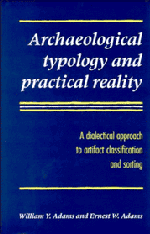 Archaeological Typology and Practical Reality
Archaeological Typology and Practical Reality Book contents
- Frontmatter
- Contents
- List of figures
- List of tables
- The archaeologist's preface
- The philosopher's preface
- PART I Introductory
- PART II The nature of types and typologies
- PART III Typology in action: the Medieval Nubian Pottery Typology
- PART IV Pragmatics of archaeological typology
- 13 The starting point: purpose
- 14 The determinants of types: variables and attributes
- 15 The making of types: formulation, designation and description
- 16 The use of types: typing and sorting
- 17 The ordering of types: taxonomy and seriation
- 18 Variation and variability in archaeological classifications
- 19 The bottom line: practicality
- 20 Principles of practical typology
- 21 Information-theoretic formulations
- PART V Classification, explanation, and theory
- Appendices
- References
- Index
14 - The determinants of types: variables and attributes
Published online by Cambridge University Press: 23 November 2009
- Frontmatter
- Contents
- List of figures
- List of tables
- The archaeologist's preface
- The philosopher's preface
- PART I Introductory
- PART II The nature of types and typologies
- PART III Typology in action: the Medieval Nubian Pottery Typology
- PART IV Pragmatics of archaeological typology
- 13 The starting point: purpose
- 14 The determinants of types: variables and attributes
- 15 The making of types: formulation, designation and description
- 16 The use of types: typing and sorting
- 17 The ordering of types: taxonomy and seriation
- 18 Variation and variability in archaeological classifications
- 19 The bottom line: practicality
- 20 Principles of practical typology
- 21 Information-theoretic formulations
- PART V Classification, explanation, and theory
- Appendices
- References
- Index
Summary
As we saw in Chapter 4, any classification is basically a set of categories. In scientific classifications, the key to formulating such categories is selectivity. That is, scientific classifications are always based on a consideration of some features but not of others, a selection of certain variables and attributes from a wider field of possibilities. What is involved, as Foucault (1973: 132–3) observes, is a deliberate narrowing of the scientist's field of vision, so that certain kinds or domains of information are systematically excluded; for example, color in the case of most stone tool types. It was the introduction of this factor of selectivity which made possible the pioneering classifications of Linnaeus (1735) and other natural scientists of the eighteenth century, whereas their predecessors had aimed at all-inclusive and non-selective descriptions of each biological species that in effect made classification impossible (cf. Foucault 1973: 125–65).
In the last chapter we saw how different purposes affect the choice of features to be considered and not to be considered in making typologies (cf. also Whallon 1982). Here we want to take a closer look at the features themselves. We will categorize them under three headings: invariants, variables, and attributes. Throughout this chapter it is important to bear in mind our distinction between type concepts and type members (see Chapter 3), and to realize that we are talking about the attributes of types (i.e. concepts), and not necessarily about the attributes of individual objects.
- Type
- Chapter
- Information
- Archaeological Typology and Practical RealityA Dialectical Approach to Artifact Classification and Sorting, pp. 169 - 181Publisher: Cambridge University PressPrint publication year: 1991


